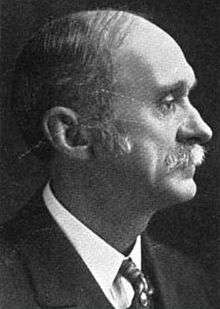John E. Weeks
| John E. Weeks | |
|---|---|
 John E. Weeks, Vermont Governor, 1927-1931 | |
| Member of the U.S. House of Representatives from Vermont's 1st district | |
|
In office March 4, 1931 – March 3, 1933 | |
| Preceded by | Elbert S. Brigham |
| Succeeded by | District eliminated |
| 61st Governor of Vermont | |
|
In office January 6, 1927 – January 8, 1931 | |
| Lieutenant |
Hollister Jackson Stanley C. Wilson |
| Preceded by | Franklin S. Billings |
| Succeeded by | Stanley C. Wilson |
| Member of the Vermont House of Representatives | |
|
In office 1912 1915 | |
| Member of the Vermont Senate | |
|
In office 1896 | |
| Personal details | |
| Born |
John Eliakim Weeks June 14, 1853 Salisbury, Vermont |
| Died |
September 10, 1949 (aged 96) Middlebury, Vermont |
| Political party | Republican |
| Spouse(s) | Hattie J. Dyer |
| Profession |
Banker Businessman Politician |
John Eliakim Weeks (June 14, 1853 – September 10, 1949) was an American politician from Vermont. He served as the 61st Governor of Vermont from 1927 to 1931.
Early life
Weeks was born in Salisbury, Addison County, on June 14, 1853. He attended the county schools and Middlebury High School. He married Hattie J. Dyer Of Salisbury in 1879.[1]
Career
Weeks operated a farm, engaged in banking, and operated several other businesses, including growing and selling hay, raising and selling livestock, and appraising and settling estates.
A Republican, Weeks served as Addison County Assistant Judge from 1884 to 1886. He was a member of the Vermont House of Representatives in 1888. He moved to Middlebury, Vermont, in 1896 and that year was also elected to the Vermont State Senate. In 1896 he was also elected trustee of the state industrial school (later named the Weeks School).[2] He served as Assistant Judge again from 1902 to 1904. He returned to the Vermont House in 1912, and was Speaker from 1915 to 1917. Weeks became Director of State Institutions in 1917 and served until 1923.[3] Weeks was Vermont's Commissioner of Public Welfare from 1923 to 1926.
Weeks was elected Governor in 1926. In 1928 he became the first Vermont Governor elected to a second two-year term, arguing that he should be given an exemption from the Republican Party's Mountain Rule in order to oversee efforts to recover from the great flood of 1927. Weeks served from January 6, 1927 to January 8, 1931. In addition to flood recovery efforts, the Weeks administration was marked by an average of forty-nine miles of road annually being paved on a pay-as-you-go basis.[4]
In 1930, Weeks was elected to the United States House of Representatives from Vermont's 1st District. This district was scheduled to be eliminated due to redistricting, and Weeks argued that serving one term and then retiring would be a fitting capstone to his career, and would ensure that two incumbent Republicans did not have to run against each other in a primary in 1932. Weeks served one term, 1931 to 1933.[5] After serving in Congress, Weeks returned to his Middlebury business interests.
Death
Weeks died in Middlebury on September 10, 1949. At 96 years and 88 days, he remains the longest lived of all Vermont governors. He is interred at West Salisbury Cemetery, Salisbury, Vermont.[6]
References
- ↑ John E. Weeks. Encyclopedia, Vermont Biography. Retrieved 16 November 2012.
- ↑ "John E. Weeks". Biographical Directory of the United States Congress. Retrieved 16 November 2012.
- ↑ "John E.Weeks". The Political Graveyard. Retrieved 16 November 2012.
- ↑ "John E. Weeks". National Governors Association. Retrieved 16 November 2012.
- ↑ "John E. Weeks". Govtrack US Congress. Retrieved 16 November 2012.
- ↑ "John E. Weeks". Find A Grave. Retrieved 16 November 2012.
External links
| Wikimedia Commons has media related to John E. Weeks. |
- United States Congress. "John E. Weeks (id: W000244)". Biographical Directory of the United States Congress.
- Inventory of the John Eliakim Weeks Papers, Special Collections, University of Vermont Library
- National Governors Association
- Encyclopedia, Vermont Biography
- Find A Grave
- Govetrack US Congress
| Political offices | ||
|---|---|---|
| Preceded by Franklin S. Billings |
Governor of Vermont 1927–1931 |
Succeeded by Stanley C. Wilson |
| United States House of Representatives | ||
| Preceded by Elbert S. Brigham |
U.S. Representative from Vermont's 1st district 1931–1933 |
Succeeded by Ernest Willard Gibson |
